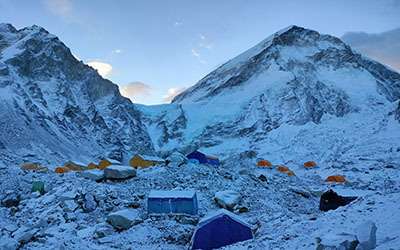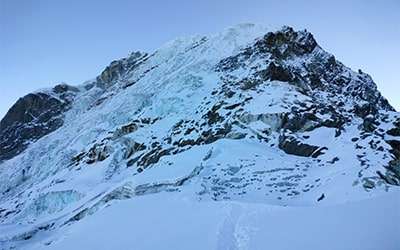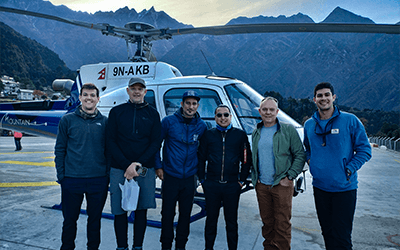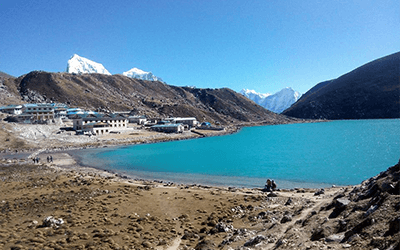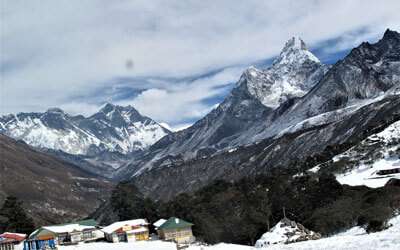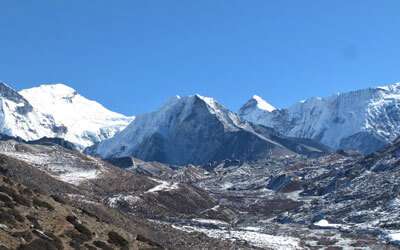Himalayan Dynasty welcomes you to Nepal, and we hope that your stay here will be a pleasant one. The following information has been compiled to give you an idea of what to expect as per the package you signed up for. However, your Group Leader will cover all the crucial details during his trek briefing. You may keep this for touring later after you are more settled.
IN KATHMANDU:
All of our treks in Nepal start with at least one day in Kathmandu. On arrival, you should proceed through Customs / Immigration. Once you have passed through Immigration please collect your baggage and proceed through the exit point where you will meet HIMALAYAN DYNASTY representative with the company’s’ CLIP / SIGN BOARD to welcome and transfer you to the designated hotel in Kathmandu.
The hotel accommodation in Kathmandu would be on a twin bed sharing room in a 3-star hotel on bed and breakfast basis. Trek briefing will be organized in Kathmandu hotel by your Group Leader making sure all of the trekkers have proper gears and are prepared for their long-awaited adventure holiday. Your leader will provide you with the necessary equipment like a sleeping bag, jackets, etc as per your requirements. Should you have any queries feel free to ask your group leader or the hotel reception who are always pleased to assist you. Single supplements would be provided as per the requirement on a trivial additional cost.
Since we don’t consider drinking water straight from the tap to be safe, we request you to use boiled water or the mineral water provided in your rooms.
CULTURAL CONSIDERATION:
Since Nepal has only been open to the outside world since 1951 and despite in the midst of great social transformation, Nepal still thrives as a very spiritual and conventional country. Though Nepali people consider foreigners as special guest yet they are expected to respect and respond to the Nepalese customs, social norms, and beliefs sensitively. Nudity and presenting of an intimate relationship are totally unacceptable. Typically, they greet with a ‘Namaste’ "Nah-mah-stay", it’s a gesture of greeting which is performed by placing our hands together to our heart and slightly bow our head. Namaste literally means "I bow to the divine in you".
Respect holy places – preserve what you have come to see, never touch or remove religious objects. When entering any Nepalese home, temples, and monasteries, always remove your shoes. When taking photographs, respect privacy – ask for permission and use restraint. Many Hindu temples may not be open to non-Hindus. Always ask permission before entering.
While giving or taking anything Nepalese use two hands which is a symbol of respect rather than doing it with just one hand. However, offering things to the begging children is highly discouraged because it only encourages begging. If you would like to donate to any school or charity organization, your group leader will always be there to guide you to do it in an appropriate method.
MONEY EXCHANGE:
As for exchanging the foreign currency, you can either do it from the Banks or from any of the registered Money Exchange counters that we have in the Thamel area. However, we don’t persuade carrying too much cash due to the high probability of it being lost or stolen. Withdrawing money from the ATM is very preferable though the cash you receive from the ATM is always Nepali Rupees. ATMs can be the most convenient way to get at your money, again the downside is - they are not always a good value. There might be a certain amount of transaction fees you may have to face when using an ATM in Nepal.
Under the new provision, a person can withdraw only Rs. 20,000 (equivalent to $200) from the ATM in a single transaction. Similarly, the central bank has also slashed the maximum single-day withdrawal limit to only Rs. 40,000.
There are normally no exchange facilities on the trek so your trek leader will be giving you necessary guidelines as to how much approximately you are to carry.
PERSONAL EXPENSES:
The equivalent of US$ 15 per day per trekking forpersonal expenses like shower, battery charging, wifi, Ocassional drinks etc. is usually sufficient. However it also depends on your spending preferences or habit. We also recommend you to carry about USD 300 extra as emergency cash. The amount required in Kathmandu for meals, sightseeing and transport would normally be covered by about US$ 40 per day. Shopping will vary greatly from person to person.
TRANSPORTATION IN KATHMANDU:
Taxis:
All Taxis running in Kathmandu have signs on their roofs and all have black and white number plates. Taxis are abundant in Kathmandu and they have price meters. We request you to insist upon the driver using the meters or you may simply ask the hotel or your leader regarding the approximate taxi fare to get to the destination you are planning to visit. All Taxis running during the night have slightly higher rates than the day prices which is there by law.
Local Transportation:
There are public Buses, mini-buses, or micro vans that ply fixed routes at regular intervals. The public transportation service is fairly frequent and they are super cheap compared to the taxis. But due to their regular stops for the passengers they don’t make in a good time. They are fairly express though. So if you are in a tight schedule public transportation won’t be a good idea. Always ask the locals before you board any public vehicles as different vehicles run to different destinations.
Rickshaws:
Rickshaws are a fun way to get around Kathmandu. They are basically meant for short trips within the city areas. We recommend you to negotiate with the fares in advance. However, to rickshaw ride around the Thamel area would be an awesome experience – it’s not expensive though.
Two Wheelers:
Cycles and Motorbikes can always be hired for a day or as per your requirements. However, we don’t really recommend two-wheelers self-riding in Kathmandu as our traffic is somewhat different and chaotic compared to what you have in your country. It isn’t safe unless you are conditioned to driving in a similar traffic scenario. And without a doubt, Kathmandu is not a place to learn two-wheelers driving.
SIGHTSEEING:
Your free time in Kathmandu will normally be spent on exploration or Shopping or last-minute purchases and getting organized for the trek. However, if you are looking for additional sightseeing before or after your trek, feel free to contact us or your group leader for touring suggestions. We can very easily arrange a guided tour including transportation which will be an ideal way to see the city.
You also may like to consider an Everest Mountain Flight for one of these days in Kathmandu that offers you the magnificent mountain vistas and the aerial view of the deep canyons, contact our staff.
YOUR VALUABLE SAFETY: STORAGE:
While in Kathmandu please do not leave your room unlocked. If you are out on a short stroll or on any appointments, make sure to accommodate and secure your valuables – that can either be in your locked luggage or hotel safety deposit box.
Before we depart for our incredible adventure your leader will organize a safety store facility for your left luggage and the safety deposit box for your valuables that you wish to leave behind. However, please follow the hotel safety guideline over the loss of key to your deposit box. While trekking never leave your valuables unattained. It’s always safe to carry them on your daypack. Make sure to lock your Tea-House rooms while going out even if it’s for a short time period. In case of loss or theft please report it to the nearest police check post where you need to obtain a written report. In any such situation, your group leader would be the best person to talk to.
FLYING TO LUKLA:
The 20 minutes’ flight to Lukla from Ramechhap Airport is one of the most thrilling experiences that delivers you the most incredible mountain flight with a view. Landing in the inclined airstrip of Lukla is something of great significance. It is always very tricky to predict the weather in the mountain. Furthermore, anyone flying high to these high altitude airports must be aware of the fact that the delays and cancellation are common episodes. Besides, anyone by any chance is flying to Lukla from Kathmandu airport they are to be aware of the fact that our international airport having one single airstrip for both international and domestic so the probability of delays is high. Thus, anyone flying to Lukla must be prepared to take the uncertainty with patience. However, it’s not a daily story. And it’s always very wise to have a contingency day in Kathmandu to cushion any cancellation situation. Though listed as a Dangerous Airport in the world the pleasure of flying to Lukla is an experience of a lifetime that is not to be missed. In fact, what’s the point of living a life of fear?
WEIGHT LIMITATION
15 Kilograms / 33 Pounds is the weight limitation in the Domestic airlines flying to Lukla and at the same time, all companies are to abide by the porter weight restrictions rules that prevail in our country. 15 Kg / 33 Lbs is your overall baggage weight that includes your daypack and your luggage. However, it doesn’t sincerely require to be an exact figure of 15 kg, 1 or 2 Kg extras per person wouldn’t make a much difference. Few things that wouldn’t count would be the items that you are taking with you in your flight like water, camera, wallet, etc. Besides, the porter luggage weight limitation is 30 kg / 66 pounds and one porter will be dealing with 2 duffel bags. So it’s always best to minimize your weight limitations. However, regarding what you need to bring carry with you is given in detail at our Trip Information page.
HEALTH:
Health is certainly significant when you are traveling to any parts of the world. To enter Nepal, there are no mandatory vaccinations. However, we suggest you to consult a doctor before you leave your country for any necessary vaccination they so choose its obligatory. We recommend you not to drink water straight from the tap. You can always drink boiled and cooled water provided by your staff or you may buy boiled and filtered water from any teahouses on the way at minimal costs.
While on your trek your leader provides you with the necessary guidelines on food to get away with food poisoning or any stomach related ailments due to new diets. However, we follow strict hygiene guidelines so all the foods in the Everest Region tea-houses are hygienically prepared under your Group leaders survey. As you all know that ‘Travellers’ Diarrhoea’ is the body’s natural reaction to new diets and new water with different mineral content. So stick to something healthy till you get acclimatized to all the new diets. Make sure you avoid too much oily food and especially meat that comes all the way from the lowland.
In case of any health issues, you can always talk to your group leader who is medically trained and counsel you with necessary precautions or medication to treat any mountain ailments that he has been trained for. You do not need to carry an extensive medical kit as your Trekking Group Leader carries a comprehensive first aid kit for the group and staff. However, we do advise you to carry your personal prescribed medicine.
PHYSICAL PREPARATION
The level of fitness is required for Everest Base Camp Trekking as it is exclusively physical. Here we are not asking for something hard-core as we don’t consider trekking to be a contest to demonstrate your level of fitness. We believe trekking to be your ultimate holiday rather than a competition to prove how fit and strong we are. We keep a convenient pace so that your holiday is challenging but not very exhausting. You can set up your own pace and time to enjoy the most fascinating surroundings rather-than being bothered about keeping up.
Our mantra while doing any of Everest Trekking is associated with THREE ‘S’ is “Slowly, Steadily, but Surely”. Trekking is indeed a holiday being with nature, the local environment and in the wilderness, yet few weeks of physical homework is required to support you while enjoying your freedom. The best physical preparation is to walk and be conditioned with your physical strength carrying your day-pack and wearing the boots you plan to wear on the trek. 3 – 4 weeks of basic physical preparation prior to your arrival to Kathmandu will be much as necessary. Alongside, Jogging, swimming, gym workouts would add further assistance in your health fitness.
A TYPICAL TREKKING DAY:
Everest Base Camp trekking days are designed so that the walking is both challenging and enjoyable. The companionship of other trekkers of a similar frame of mind, plus the barely contained excitement and positive attitude of the Nepalese staff create a great company and many happy moments.
Each day has its different attraction which is mostly controlled by a number of factors from the availability of suitable teahouse or campsite, trail conditions, and general walking pace of the group. Exact time schedule may not be always followed, as it would in fact destroy the free and easy stroll along the trails that you have come to enjoy and experience the difference. So the following schedule is just a guideline.
The day begins early at around 6.00 to 6.30 am with a cup of tea. Before breakfast, pack your gears into a duffle bag by keeping some essential items like camera, rain jackets, water bottles, sunscreen, toilet roll, appropriate warm clothes, sunglasses, etc. in your day pack since you will not have access to your duffel bag until you arrive to our next destination. Your duffel bag will be loaded into one of the porters' loads along with the other members of the group gear and will head off along the trail while you have your breakfast.
NOTE: Please don’t pack any fragile items in the duffel bag unless you inform about it to your guide or local staff.
After breakfast, we are usually on the trail around 7.30 to 8.00 am, and following a morning walk, we stop for lunch at around 11 to 12 o'clock. About 1 ½ hour lunch break allows you to enjoy the surroundings, so relax, catch up on your diary or reading. We reach camp or teahouse by 3 – 4 p.m., as the afternoon walk is generally shorter than the morning. Having afternoon tea, side trips, games or other activities (optional) are generally organized by the trekking group leader/guide or you can opt to relax, read, write a diary, explore the surrounding area and villages or sit and chat with staff or local people or fellow trekkers. Dinner is normally served around 7.30 pm. Every evening your trekking Group Leader/guide will brief you about the next day program. Chatting and fun activities with your staff generally fill the evenings. Most trekkers remember these evenings as one of the highlights of their trip.
TREK ACCOMMODATION:
Accommodation at Everest Base Camp Trekking is essentially in the tea-house that will be basic on twin bed sharing room with common toilets. Rooms with attached toilets and the single supplement will be provided depending on the availability as not all destinations in the Everest region offer a single supplement due to the limitation of tea-houses over the restrictions and obligations of National park rules and regulations.
FOOD ON THE TRAIL:
Kathmandu breakfast is included beside the welcome dinner in a traditional royal Nepali restaurant. All Standard Meals i.e. Breakfast, Lunch and Dinner are included in your Everst Base Camp Trekking Package along with the choice of hot beverage.We offer you an open menu so you will have a choice of your meal. Like many companies we don't limit the meals at one course however we kindly request you not to waste any food. In our entire trip, we will eat all the meals in the local Tea-houses including our lunch and our staff will make sure that your food is prepared with hygiene. You will be amazed to find the variation of food menu in such remote regions of Nepal. Furthermore, all Tea-Houses in the Everest region give their best to provide you food that is nutritious, plentiful, and tasty. We can also cater for specific dietary needs if you advise in advance besides our delicious mixture of Nepalese, Indian, Chinese, and continental food.
EVEREST TREKKING TRAIL:
Everest Three Passes Trekking involves a great number of ups and down walking. Furthermore, it includes remarkable walking into a series of rocky steps, hill-cut trails, boulders and moraine trails. However, trekking in Everest doesn’t actually require a technical experience other than being slow and taking pleasure. But despite all these, the beautiful panoramic views of the towering Himalayas and stunning Sherpa cultured villages with the influence of Tibetan Buddhism eventually gives you an amazing impression of the magic of Nepal and you will appreciate why trekking is the ultimate holiday. We believe that your adventure trek is a holiday of a lifetime and we try our best to pay attention to day to day detail so you enjoy as much as possible. Our field staff will assist you while trekking by carrying your daypack or helping over more difficult sections as required.
DIFFICULTY LEVEL:
Though the epic trip to Everest Three Passes Trek is phenomenal offering anyone a great trekking experience with panoramic mountain views yet it is challenging.In total Everest Three Passes Trek is approximately three weeks long out which we spend more than 2/3 of the time over 4000 m and we frequently go higher than 5000m. It is a Strenuous-Challenging trek due to its duration, Altitude variation and thin air yet it is achievable for anyone with sound fitness. Anybody of any age group can join as our itineraries are intended to make the trip more pleasing than exhausting nonetheless, we recommend pre-physical training and your doctors’ consent in regards personal ailments, weak ankle/knee, blood pressure, heart problem, etc.
We usually walk 5/6 hours every day excluding Lunch break. We normally start early so that we could reach our destination at the given time which in return contributes to more space to explore and enjoy the serenity of the place. To make every day more memorable and relaxed we set up a convenient pace for everyone giving you ample time to enjoy and acclimate.We start from treeline through a very established trail gradually walking into the alpine terrain on a beaten track and eventually walking into thin air on a moraine or boulder trail – which means certain walking experience into the wild is necessary.
WEATHER / BEST TIME TO TREK:
The temperate climate in Nepal is affected by monsoon, which sweeps up from the Bay of Bengal every summer making mid-June to mid-September wet and humid. During the monsoon time, the Nepal Himalayan region is not ideal for trekking with an exception of a few remote valleys in high terrain. We operate delightful trips into the forbidden kingdom and the restricted province of Upper Mustang and Upper Dolpo in Monsoon season. The following three distinct seasons, all of which are suitable for the Everest Base Camp Trekking having their own advantages.
Autumn (Mid-September to November): is usually considered as the best and most popular time for the trekking in Nepal. During this season generally the clear sky and mild to warm days / cool nights enhance your stay in all these fascinating mountains, as the countryside gets lush and green. Gradually it gets cooler later in this season, as the winter approaches.
Winter (December to February): Though not an appropriate time to trek to Everest, winter is however considered as an ideal time to visit Nepal by large number of experienced trekkers despite the colder conditions. It usually provides a clear sky delivering magnificent views despite the low temperature. Though days are cooler and nights are extremely cold however, it offers the tremendous advantage of being less crowded trails. However, January and February aren’t ideal for trekking to Everest Base camp due to the high chill factor and the probability of most lodges being closed as all water supplies will be frozen.
Spring (March to Early June): By March the cold and dry season begins to give way to milder, moister spring conditions. Mornings are usually clear giving enough time to comprehend and photograph these entire magic fold mountains; occasionally cloud build-up brings afternoon rainstorms with the gradual increase of daytime temperature. This season has clear weather at the higher altitude with the spectacular displays of rhododendrons and other flowers.
MOTIVATION AS ABSOLUTE NECESSITY:
The most significant factor while doing Everest Base Camp trekking which is overlooked quite often is ‘MOTIVATION’. Mental preparation is inseparable from physical, it’s your mind and not your body that determines what you are capable of doing providing you with goal-oriented behavior. If you want to succeed and make your freedom of trekking the most pleasant of all then inspiration to know your potential and significantly believing in yourself is important. While doing EBC Trek, simply providing you with our best professionals isn’t enough to guarantee you a safe passage, in fact it’s you and your positive outlook that makes the whole thing go exactly the way you want.
CAPTURE MEMORIES / PHOTOGRAPHY:
The beautiful region of Everest offers you ample opportunity for photography which has so much to present you with its stunning and spectacular scenery and its respectful SHERPA people. Everest has never failed to lure the professionals and has actually served as a platform for emerging photographers. Taking away the pictures of innocent faces of Nepali people is an excellent opportunity but some are with religious belief against being photographed so it is always polite to ask for permission first. Nonetheless, batteries die very soon at higher altitudes while doing Everest Trekking due to cold temperature environment so it is always sensible to carry extras though you have a charging facility in almost every stop at a minimal fee.
ENVIRONMENTAL ASPECTS:
Himalayan Dynasty being an environmentally friendly trekking company, preservation, and conservation of the fragile environment is our topmost concern and we try our best to minimize all the negative impacts of our presence in the areas we visit. Mineral water is rampant in Everest region yet for environmental concern WE are opposed to the use of disposable plastic bottles on any of our trips to Nepal Himalayas. With no additional cost all through the Everest Base Camp trek our staff will supply you with appropriately boiled water every morning and evening for which at least 2 metal or plastic Nalgene bottles are recommended. In case you run out of the delivered water you can always buy boiled and filtered water from the tea houses along the way at minimal charges.
We at the most prefer to stay in the tea-house where they prepare the meals using Kerosene or alternative energy. Moreover, we discourage our valued guests to use hot showers if the water is heated on firewood in teahouses along the trail.
We organize Eco trekking Workshop every year, which trains our staff in regards to conserving the environment and give our best to commit ourselves to fully establish an environmentally friendly trekking company. We hope you appreciate the need for our guidelines – following them will help to protect and preserve this beautiful region for future visitors.
TRIP EXTENSIONS:
Trip extensions can always be worked out while booking your trip or after you are done with your trip. Along with the Everest Base Camp Trekking, depending on your schedule and requirements we can always arrange best trip extensions that would correspond to your need. However, exploring Kathmandu, Tour to the ancient city of Bhaktapur, Short hike to Nagarkot for the best sunrise and sunset view, trip to Chitwan National Park, trip to Pokhara, paragliding, rafting, etc. are the some of the most phenomenal extensions illustrations.
TIPPING GUIDANCE
Tipping is an entirely personal matter. - It is also an indication of your satisfaction with the service delivered by our local trekking crew. As they work really hard to make your holiday the most memorable one, tipping is more like a token of gratitude of saying THANK YOU to your local crew. As a guideline average tipping is around 10% of your trip cost per trekker. Many people also like to donate various items of equipment to the porters and trek staff who would very warmly receive these items. Your Group Leader will make arrangements for a fair distribution of your gratitude and the used items (possibly by raffle) amongst the trek crew. We recommend you to make separate tipping for your trekking Group Leader.
AIRPORT PORTER:
NOTE: We strongly suggest NOT TO TIP OR GIVE AWAY ANY OF YOUR BAGS to any of the AIRPORT PORTERS on your arrival in the Kathmandu Airport other than the Himalayan Dynasty Representative. Do check your bags while loading into the provided car/van for the hotel. We suggest you to separate US$ 1 OR 2 only to pay the bell boy in the Hotel.
FEEDBACKS / RECOMMENDATION / WORD OF MOUTH
As a typical Local company, the Himalayan Dynasty is trying its best to stand out among ample international companies and local companies with Overseas Agents. After the completion of your trip, considering our service if you could kindly spare your precious little time to evaluate us through positive reviews – it will be very motivating for us to rise in the years to come. Your one excellent review will unquestionably mean a world to us and it does really count a lot making a huge difference. Your generous support, feedback, and recommending Himalayan Dynasty to your acquaintances will be very influencing and will surely inspire us to stand out with a difference.


